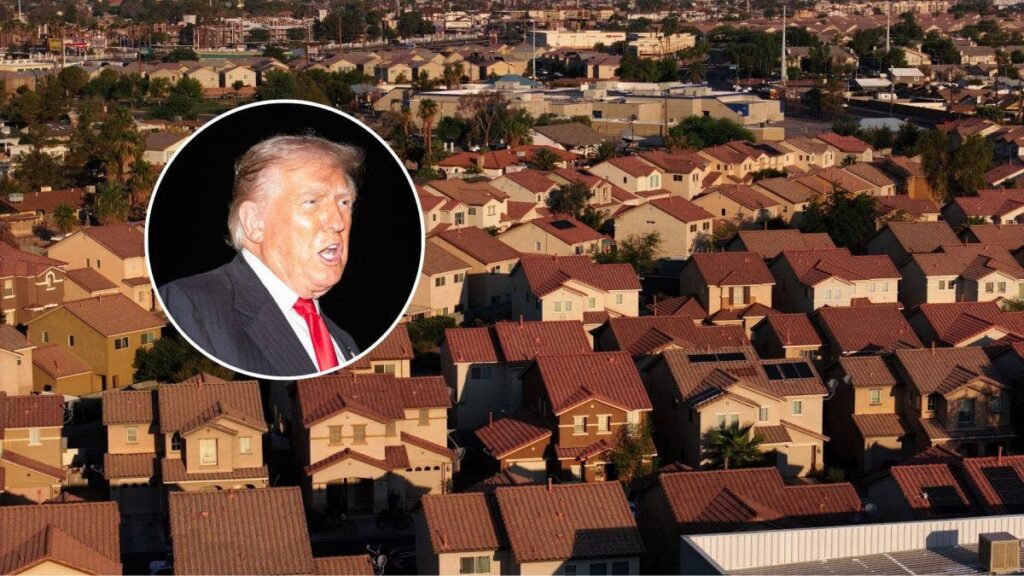President Donald Trump’s idea to introduce a 50-year mortgage rate is being picked apart by housing and economics experts, who have expressed skepticism over how impactful such a move would be in improving affordability for millions of Americans currently struggling to get on the property ladder.
Trump first floated the idea over the weekend, sharing a graphic on his social media platform Truth Social where his portrait was side-by-side with that of Franklin D. Roosevelt under a banner reading: “Great American Presidents.” Under Roosevelt’s portrait, the graphic said “30-year mortgage,” which the then-president introduced during the 1940s. Under Trump’s portrait, it said “50-year mortgage.”
Shortly after, the Trump-appointed director of the Federal Housing Finance Agency (FHFA) William Pulte confirmed on X that the Trump administration was considering introducing a 50-year mortgage as a “complete game changer” for affordability in the U.S. housing market.
Housing costs have skyrocketed in the years following the outbreak of the pandemic, and mortgage rates have hovered between 6 percent and 7 percent since 2022, chipping away at Americans’ purchasing power.
Introducing a 50-year mortgage could help individuals and families facing higher borrowing and homeownership costs, but experts warn that any benefit could be easily outweighed by dragging on payments for 20 years longer than the standard 30-year term.
What Is The Point Of Introducing A 50-Year Mortgage?
The appeal of a 50-year mortgage “is to offer lower monthly payments to homebuyers and break up the log jam of the current housing market which has struggled in terms of sales pace all year,” Joel Berner, senior economist at Realtor.com, told Newsweek.
But experts are skeptical of what its impact would be on the U.S. housing market over time, and many have been vocal in their criticism of the proposal, with CEO of American investment firm Azoria James Fishback calling it “a disgusting insult” and “economic genocide against the Gen Z generation.”
“The drawbacks are that a 50-year mortgage results in almost double the interest payments of a 30-year mortgage and a longer path to meaningful home equity,” Berner said, “and that the result of subsidizing home demand without increasing home supply could be an increase to home prices that negates the potential savings.”
The design of the Trump administration’s proposal is to boost homebuyer demand, Berner said, which has been “subdued” for the last several years as mortgage rates have been stuck in the 6+ percent range. But an unwanted consequence might be to make homeownership even more expensive for Americans.
“More flexible financing is essentially a subsidy for housing demand, which will add to the pool and buying power of homebuyers without increasing the supply of homes,” Berner said. This, in turn, “will drive home prices up,” he warned.
“The ‘savings’ from 50-year mortgages may be totally negated by rising home prices,” Berner said.
How Would The Trump Administration Go About This?
Bankrate Housing Market Analyst Jeff Ostrowski told Newsweek that, presumably, the FHFA could direct Fannie and Freddie to begin offering 50-year loans, and lenders could begin originating them.
But questions remain over how the Trump administration would concretely implement such a change—something that both the president and the FHFA director have offered very little information about.
“One big question is how investors would react,” Ostrowski said. “Most mortgages are re-sold to investors, and this would be a new product,” he added.
“Another question is how much higher mortgage rates would be on 50-year loans. Rates would have to be somewhat higher for lenders and investors to accept the risk.”
What Would Be Its Impact On Borrowing Costs?
According to Berner, rates would be higher on the 50-year loan “in the same way that 30-year rates are higher than 15-year rates,” he said. “The longer the life of the loan, the more compensation the lender will demand.”
With those assumptions—and the additional assumption of a 6.25 percent rate—, a 50-year loan would save “at most” about $250 per month compared to the 30-year loan, Berner estimated.
“I say ‘at most’ because I assumed the same rate for both, which would probably not be the case,” he said. “Total interest on the 50-year loan would amount to $816,396 compared to $438,156 on the 30-year loan, a difference of $378,240. That’s 86 percent more interest over the life of the loans,” he said.
“After 10 years of homeownership you’d have $345,564 as a balance on your 50-year loan compared to $303,256 on the 30-year. That’s a difference of $42,308 or 10.6 percent of the value of the home,” Berner said.
Ostrowski agrees that the savings made possible by a potential 50-year mortgage would be rather small.
“A 50-year loan would just extend the repayment period,” he told Newsweek. “Say I take a $400,000 loan at 6.25 percent for 30 years. The monthly payment would be $2,463. If you were to extend that term to 50 years and raise the rate to 7 percent, the monthly payment falls to $2,407,” he estimated.
This would make the loan “a little more affordable,” he said, “but are 10 lattes a month really enough to motivate a borrower to extend the repayment period?”
According to Ostrowski, Trump’s proposal would be “a minor shift rather than a monumental one.”
For Berner, introducing a 50-year mortgage rate “is not the best way to solve housing affordability.” The Trump administration, in his opinion, “would do better to reverse tariff-induced inflation, which is keeping the rates on existing mortgages high, and to encourage the expansion of housing supply by promoting homebuilding,” he added.
“Buyers do benefit from spreading out the high cost of a home purchase over a longer period, but lenders certainly benefit too by having a longer period to charge higher interest rates.”
Read the full article here
